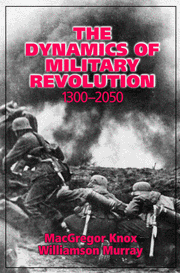Book contents
- Frontmatter
- Epigraph
- Contents
- Contributors
- Acknowledgments
- List of figures and tables
- 1 Thinking about revolutions in warfare
- 2 “As if a new sun had arisen”: England's fourteenth-century RMA
- 3 Forging the Western army in seventeenth-century France
- 4 Mass politics and nationalism as military revolution: The French Revolution and after
- 5 Surviving military revolution: The U.S. Civil War
- 6 The Prusso-German RMA, 1840–1871
- 7 The battlefleet revolution, 1885–1914
- 8 The First World War and the birth of modern warfare
- 9 May 1940: Contingency and fragility of the German RMA
- 10 Conclusion: The future behind us
- Index
8 - The First World War and the birth of modern warfare
Published online by Cambridge University Press: 05 February 2015
- Frontmatter
- Epigraph
- Contents
- Contributors
- Acknowledgments
- List of figures and tables
- 1 Thinking about revolutions in warfare
- 2 “As if a new sun had arisen”: England's fourteenth-century RMA
- 3 Forging the Western army in seventeenth-century France
- 4 Mass politics and nationalism as military revolution: The French Revolution and after
- 5 Surviving military revolution: The U.S. Civil War
- 6 The Prusso-German RMA, 1840–1871
- 7 The battlefleet revolution, 1885–1914
- 8 The First World War and the birth of modern warfare
- 9 May 1940: Contingency and fragility of the German RMA
- 10 Conclusion: The future behind us
- Index
Summary
The military revolution of the Great War fused industrial warfare and ideology into a relentless and merciless whole that ultimately – in the war's second round in 1939–45 – clasped fighting fronts and civilian populations within a single circle of fire and terror. The technological side of that revolution, “the rational and appropriate application of technical means to both attack and defense” – as one of its German authors described it – culminated in 1917–18 in perhaps the most significant conceptual development in all the long history of war.
That development was the birth of “modern style of warfare”: the advent of three-dimensional conflict through artillery indirect fire as the foundation of planning at the tactical, operational, and strategic levels of war. Three-dimensional conflict was so revolutionary that the tumultuous development of armor and air power in 1939–45 and the advent of the information age in the decades that followed amount to no more than complementary and incremental improvements upon the conceptual model laid down in 1917–18.
Many technological and tactical components of this revolution antedated the First World War, but the shock of war acted as a catalyst for its indispensable conceptual ingredients. From the solution to pressing tactical problems after 1914 emerged the unforeseen possibility that new techniques of deep attack might create a wholly new style of operations.
- Type
- Chapter
- Information
- The Dynamics of Military Revolution, 1300–2050 , pp. 132 - 153Publisher: Cambridge University PressPrint publication year: 2001
- 7
- Cited by



